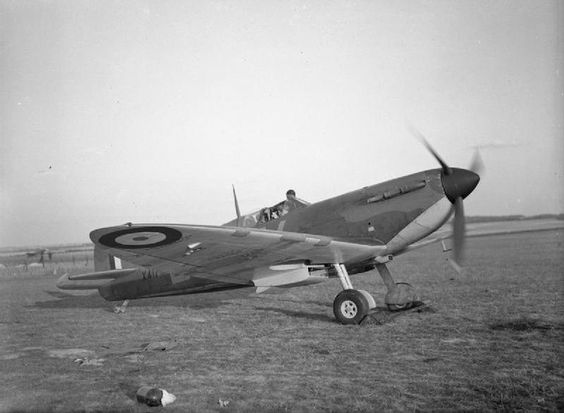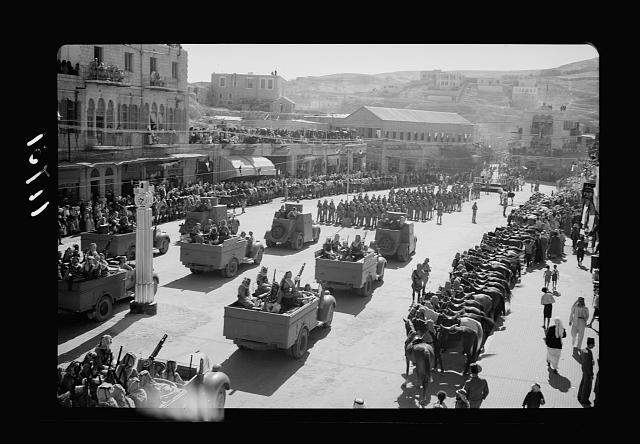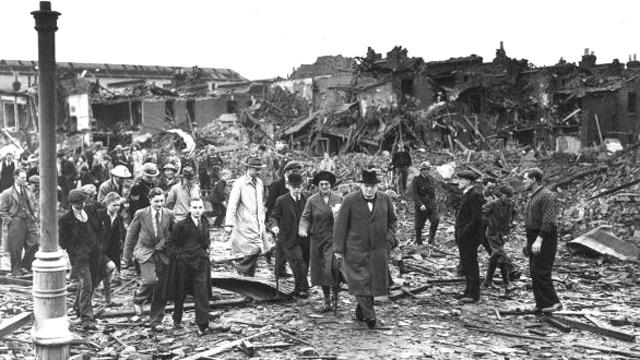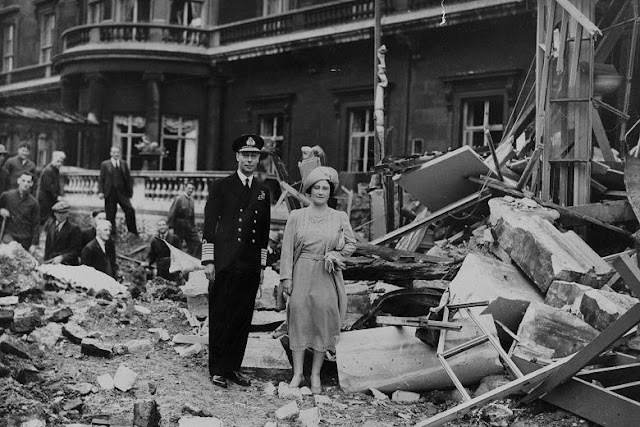Saturday 8 March 1941
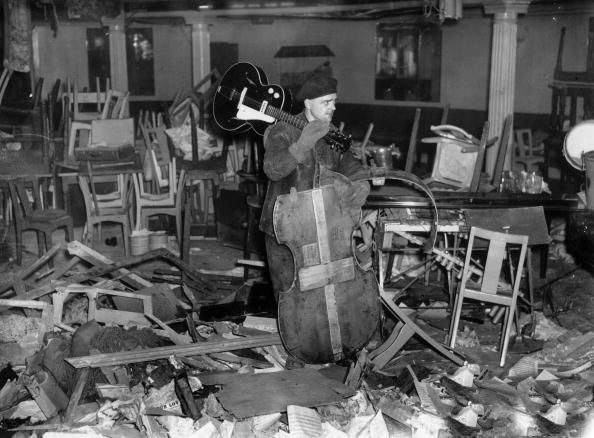 |
| Wreckage of the Cafe de Paris, 8 March 1941. |
The Regia Aeronautica is very active in the region, while the RAF bombs the port of Durazzo.
Greek Commander-in-chief Papagos believes that Yugoslavia will join the fight against the Axis. He therefore holds to his position of defending against a German attack through Bulgaria in the forward Nestos line.
East African Campaign: The operations in Italian Somaliland continue, with the British heading along the road to Mogadishu. The RAF is active throughout the region, including over Keren.
European Air Operations: The Luftwaffe sends a large raid (125 bombers) against London after dark. Among the places hit are Buckingham Palace (front courtyard quadrangle and the chapel in the south wing), The Garland's Hotel SW1, a block of London County Council (LCC) flats, and the Cafe de Paris (34 deaths and many casualties as the bomb hits during the evening performance). There is a total of 34 deaths and 60 seriously injured from the attack. Fortunately for the residents, many of the bombs fall harmlessly in Green Park. The Queen Consort almost perishes in the attack on the Palace.
The Luftwaffe also raids Plymouth. The dockyards are hit hard.
 |
| The Cafe de Paris before... |
 |
| Damage at the Cafe de Paris after the 8 March 1941 raid. |
Malaya's aircraft is the first to spot the German ships; it runs out of fuel and the crew is picked up by a passing Spanish freighter and interned. The Royal Navy dispatches Force H, led by battlecruiser HMS Renown and the aircraft carrier HMS Ark Royal from Gibraltar toward the Cape Verde Islands to search for the German cruisers, but they are long gone into the vastness of the Atlantic.
Accordingly, at 01:42 U-124 (Kptlt. Georg-Whilhelm Schulz) spots the convoy. An hour later, U-105 (Kapitänleutnant Georg Schewe) arrives as well. U-106 (Kptlt. Jürgen Oesten) also arrives during the night but makes no attacks. The two U-boats go to work on the convoy and have a big night, sinking 28,148 tons of shipping. They kill 62 sailors and wound 300 other men, collectively. Once U-105 is on the scene, the attack happens in slam-bang fashion, with all the ships sunk by the two U-boats being hit within a total of fifteen minutes. However, the real prize - the Malaya - is nowhere to be seen.
U-124 fires six torpedoes and sinks four British freighters:
- 4897-ton Hindpool (28 deaths, 12 survivors)
- 5304-ton Lahore (abandoned on the 9th, 82 survivors)
- 7974-ton Nardana (19 deaths)
- 5984-ton Tielbank (unknown)
U-105 also will be remembered as a very successful boat during World War II, but this is only its second patrol out of Lorient. It has racked up only two kills so far. The boat gets its third victim today from Convoy SL-67, sending to the bottom 5229-ton British freighter Harmodius. There are 14 deaths and 61 survivors.
Much further north, south of Iceland, the attacks on Convoy OB-293 continue. U-A torpedoes and sinks British freighter Dunaff Head. There are five deaths and 39 survivors. The Royal Navy escorts counterattack and damage U-A. This incident is often interpreted as being the attack that is often ascribed to the death of U-boat ace Guenther Prien of U-47 - whose fate is unknown.
The E-boat action that began on the 7th in the North Sea off Happisburgh, Norfolk concludes shortly after midnight. S-102 sinks 957-ton British freighter Norman Queen. There are 14 deaths, and one man is taken as a prisoner.
S-102 also, in the same night action, sinks 1547-ton British freighter Togston. There are eight deaths.
The Luftwaffe (KG 27 Heinkel He 111s) bombs and sinks 128-ton Dutch freighter Prins Frederik Hendrik in St. George's Channel off Wexford. There are 8 deaths.
The Luftwaffe bombs and sinks 700-ton Norwegian coaster Nurgis, carrying 815 bricks, off the Lizard. All 14 men on board survive, but some are injured by strafing and several near misses.
British 3724 ton freighter Francis Dawson catches fire at Halifax, Nova Scotia and is written off. The salvagers, however, are less discriminating. They tow the hulk to New York and repair it, returning the ship to service as Empire Tyne.
USS Wasp (CV-7) rescues the crew of sinking lumber schooner George E. Klinck off Cape Hatteras, North Carolina. Some accounts place this on the 7th, so the incident is listed on that page, too.
German battleship Bismarck exits the Kiel Canal and docks at Deutsche Werke (Dock C) at Kiel. She is to be supplied for a raiding expedition, including two Arado Ar-196 floatplanes. The hull is given striped camouflage paint.
German cruiser Admiral Scheer refuels from German tanker Nordmark in the South Atlantic.
Convoy OB 295 departs from Liverpool.
Canadian minesweeper HMCS Quinte is launched in British Columbia.
U-204 (Oberleutnant zur See Walter Kell) is commissioned, U-372 is launched, U-463 is laid down.
Soviet submarine K-54 is launched.
The British, meanwhile, are busy sending troops and equipment out of North Africa. Today, two British freighters (Clan Macauley and Cingalese) loaded with tanks and other equipment arrive in Piraeus, Greece. The German consulate in Piraeus overlooks the harbor, and the Wehrmacht knows exactly what is happening. Convoy AS 17 heads in the other direction, back toward Alexandria. Convoy ANF 18, meanwhile, leaves Alexandria. This will be a very busy sea lane for some time. Battleships HMS Valiant and Barham depart Suda Bay, Crete to cover the convoys.
The German mines in the Suez Canal claim another victim. This time it is a minesweeping boat, HMS Dart. There are two deaths, with the other two men badly wounded.
Egyptian 1116 ton tanker Star of Mex runs aground near Ras Assaz. It is towed off and proceeds to Alexandria for repairs.
Battle of the Pacific: In London, Australian Prime Minister Robert Menzies meets with the Admiralty leadership at Whitehall. He confides to his diary the general attitude of the officers there regarding the reinforcement of the Far East:
The real truth, which we are all beginning to see, is that air reinforcements to Singapore and the Far East is the great deterrent (apart from USA) to Japan. The [Japanese pilot] is reported to be a poor airman. Even on the naval side, the Second Sea Lord (Phillips) said British fleet would be happy to attack with only 60% of the Japanese Force. The Japanese experience in China seems to point to a similar state of affairs in the Army!The "Phillips" mentioned by Menzies is Rear Admiral Sir Tom Phillips, Vice Chief of the Naval Staff. He will lose his life on 8 December 1941 when the "poor Japanese airmen" sink his battleship.
In addition, Menzies gives the Admiralty leave to place priority on the Mediterranean Theater at the expense of the Far East should the Japanese attack. This is due to the major commitment of Australian and New Zealand ground forces in the region.
 |
| West Indian-born bandleader Ken Johnson aka "Snakehips" is decapitated by the blast at the Cafe de Paris during a performance of the Andrew Sisters' "Oh Johnny, Oh, Johnny, Oh!" |
Soviet Military: The Stavka orders mobilization of 900,000 reservists from 15 May 1941 to 20 October 1941.
US Military: The War Department awards contracts for the construction of aircraft plants to Fort Worth, Kansas City, and Tulsa. One of the government's primary considerations is that all three cities are well inland, as required by the military. Consolidated will take over the plant in Fort Worth. It states that the plant in Fort Worth, where it has been mulling building for some time, would be adequate to build a plane that would dwarf the B-24. Construction at all three sites is rushed.
US Government: The US Senate passes the Lend-Lease Bill ("An Act to Promote the Defense of the United States") with a 60-31 vote. The Bill now has passed both houses of Congress, but the bills passed by each is slightly different. The differences must be resolved in a joint Senate-House conference, and then sent back to each House for passage by each of the final Lend-Lease Bill. The amount of the funds authorized by the act is $1.3 billion.
Television is cutting-edge technology, and the government is at the stage of setting basic standards for purposes of uniformity. The National Television System Committee (NTSC) adopts 525 lines of resolution and 30 frames per second as the standard. This recommendation now goes to the Federal Communications Commission (FCC) for consideration.
While Germany is continuing its development of television broadcasts using the public airwaves, Great Britain has suspended all broadcasts for the duration of the war. This is because the British fear the signals will serve as homing beacons for Luftwaffe bombers. For comparison, the pre-war British standard was 405 lines and the French standard was 455 lines. In Germany, where broadcasts continue during the war, the standard is 441 lines. Thus, the US standard is the highest at this point among the early television pioneers.
 |
| SS Comliebank, one of the five freighters in Convoy ANF 18 departing Alexandria today bound for Piraeus. |
Dutch Homefront: The German occupation forces continue clamping down on the citizenry following the February General Strike. They proclaim martial law.
British Homefront: In Liverpool, Corporal James Patrick Scully of the Royal Pioneer Corps spends hours digging people out of a bombed-out building. He ultimately receives the George Cross.
American Homefront: Philadelphia Phillies All-Star pitcher Hugh Mulcahy is drafted. He is the first major leaguer to be drafted. While the rules state that time in service is set at one year, those will be extended after Pearl Harbor. Mulcahy finally will return to the diamond until July 1945, but his promising career effectively is over.
Warner Bros. releases "Footsteps in the Dark," directed by Lloyd Bacon and starring Errol Flynn, Brenda Marshall and Alan Hale. While the critics like it, "Footsteps in the Dark" does poorly at the box office.
 |
| The Australian Women's Weekly, Saturday 8 March 1941. |
March 1, 1941: Rettungsboje
March 2, 1941: Oath of Kufra
March 3, 1941: Germans in Bulgaria
March 4, 1941: Lofoten Islands Raid
March 5, 1941: Cooperation With Japan
March 6, 1941: Battle of Atlantic
March 7, 1941: Prien Goes Under
March 8, 1941: Cafe de Paris
March 9, 1941: Italian Spring Offensive
March 10, 1941: Humanitarian Aid
March 11, 1941: Lend Lease Become Law
March 12, 1941: A New Magna Carta
March 13, 1941: Clydeside Wrecked
March 14, 1941: Leeds Blitz
March 15, 1941: Cruisers Strike!
March 16, 1941: Kretschmer Attacks
March 17, 1941: Happy Time Ends
March 18, 1941: Woolton Pie
March 19, 1941: London Hit Hard
March 20, 1941: Romeo and Juliet
March 21, 1941: Plymouth Blitz
March 22, 1941: Grand Coulee Dam
March 23, 1941: Malta Under Siege
March 24, 1941: Afrika Korps Strikes!
March 25, 1941: Yugoslavia Joins The Party
March 26, 1941: Barchini Esplosivi
March 27, 1941: Belgrade Coup
March 28, 1941: Cape Matapan Battle
March 29, 1941: Lindbergh Rants
March 30, 1941: Commissar Order
March 31, 1941: Cookie Bombs
2020


